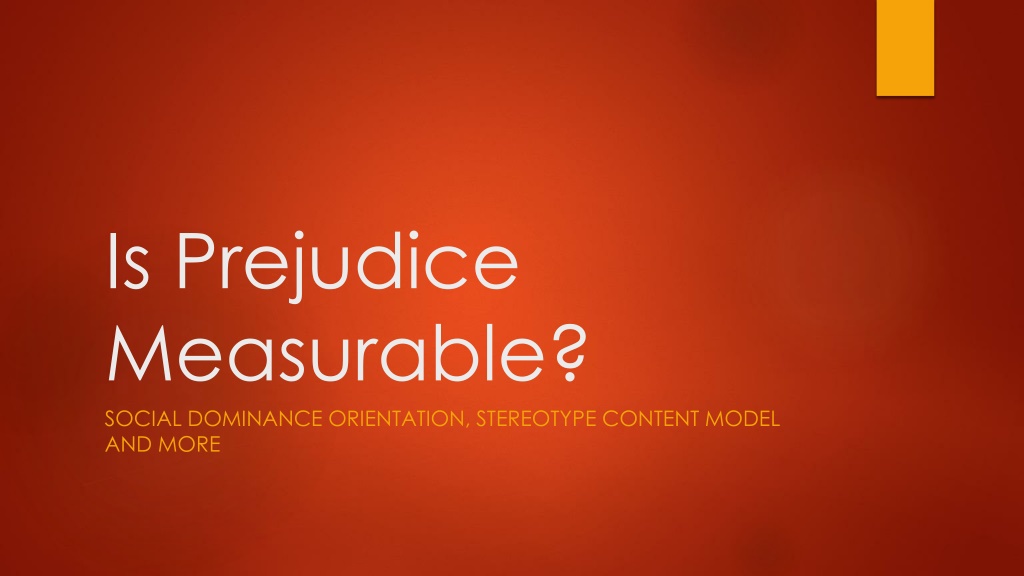Understanding Measures of Prejudice in Research: Social Dominance Orientation, Stereotype Content Model, and More
Explore methods for measuring prejudice in research, including explicit and implicit attitude measures, Social Dominance Orientation (SDO) scale, and Symbolic (Modern) Racism Scale. Learn about the aims of research, selecting appropriate methods, and theoretical frameworks to apply.
Download Presentation

Please find below an Image/Link to download the presentation.
The content on the website is provided AS IS for your information and personal use only. It may not be sold, licensed, or shared on other websites without obtaining consent from the author. Download presentation by click this link. If you encounter any issues during the download, it is possible that the publisher has removed the file from their server.
E N D
Presentation Transcript
Is Prejudice Measurable? SOCIAL DOMINANCE ORIENTATION, STEREOTYPE CONTENT MODEL AND MORE
How to choose the right method for your (immigrant-attitude)research? What is the aim of my research? What is my research question? Which categories/concepts do I need for it? Which theoretical explanations fit my research best? ... THEN How to measure it? Should I ask (measure) implicit or explicit?
Explicit attitude measure - Respondents are aware of the aim of the research - Answers can be controlled or modified - Likert scale, Thurstone attitude scale THE APPROACHES TO THE MEASURMENT Implicit attitude measure - Assess people's feelings without having to ask them directly - Focus also on those who live in a climate of political correctness - Usage of computers presenting short stimuli to respondents
Social Dominance Orientation People with high score in SDO believe that; Group hierarchies are natural and desirable World requires group competition 16- item SDO scale elicits agreement- disagreement with alleged statements Expressing preference for unequal relationships SDO assesses social dominance as opposed to individual dominance or self- esteem Correlates with: Protestant work ethic (PWE), Right wing authoritarianism (RWA) Proves group-level resource inequality, superiority, ethnocentrism
Example of SDO statements in survey questionnaire
Symbolic (Modern)Racism Scale Measure opposition to Black politicians and policies, designed to explain White racial policy attitudes Racially based pattern of policy preferences (rather than prejudices against Black people as a group Symbolic racism theory -based on new racism (x old- fashioned racism) How much discrimination against blacks do you feel, limiting their chances to get ahead? 8 item measure with several response modes
SRS An example of survey questions
Social Privilege and Assessment of Privilege Awareness Some groups are privileged, and some are oppressed The awareness of privilege could lower the social inequality
DISCUSSION Do you feel privileged? Have you realized in your daily interactions that some social groups are less privileged or even oppressed? Do you think that to be an immigrant or having immigrant background automatically means that you are less privileged? If yes, do you consider it as a problem?
Implicit association test (IAT) Intended to detect the strength of a person's subconscious association between mental representations of objects Identifies traces of the past experiences that mediate favorable or unfavorable feeling, thought, or action toward social objects Race IAT: Respondents are asked to pair 25 for example typical White names (Adam, Harry, Joe) and 25 ethnic names with 25 words with positive and 25 negative associations A bit controversial but still widely use IAT race-prejudice scores decrease with exposure to positive role models, counter-stereotypic images, social influence Online examples: https://implicit.harvard.edu/implicit https://faculty.washington.edu/agg/iat_materials.htm
Stereotype Content Model Measures specific biases directed toward systematic clusters of groups across society 2 dimensions: o Warmth; reflects the group s apparent intention for good or ill o Competence; reflects the group s apparent ability to enact the intent Liking (warmth) X Respect (competence); o high on both (middle class citizens) o low on both (homeless people) o high on one but low on the other (rich people/disabled people) Specific combinations predict emotional prejudices of pride, pity, disgust and envy o Emotions in turn predict active and passive help or harm
SCM An example of possible questions used in survey questionnaire



































